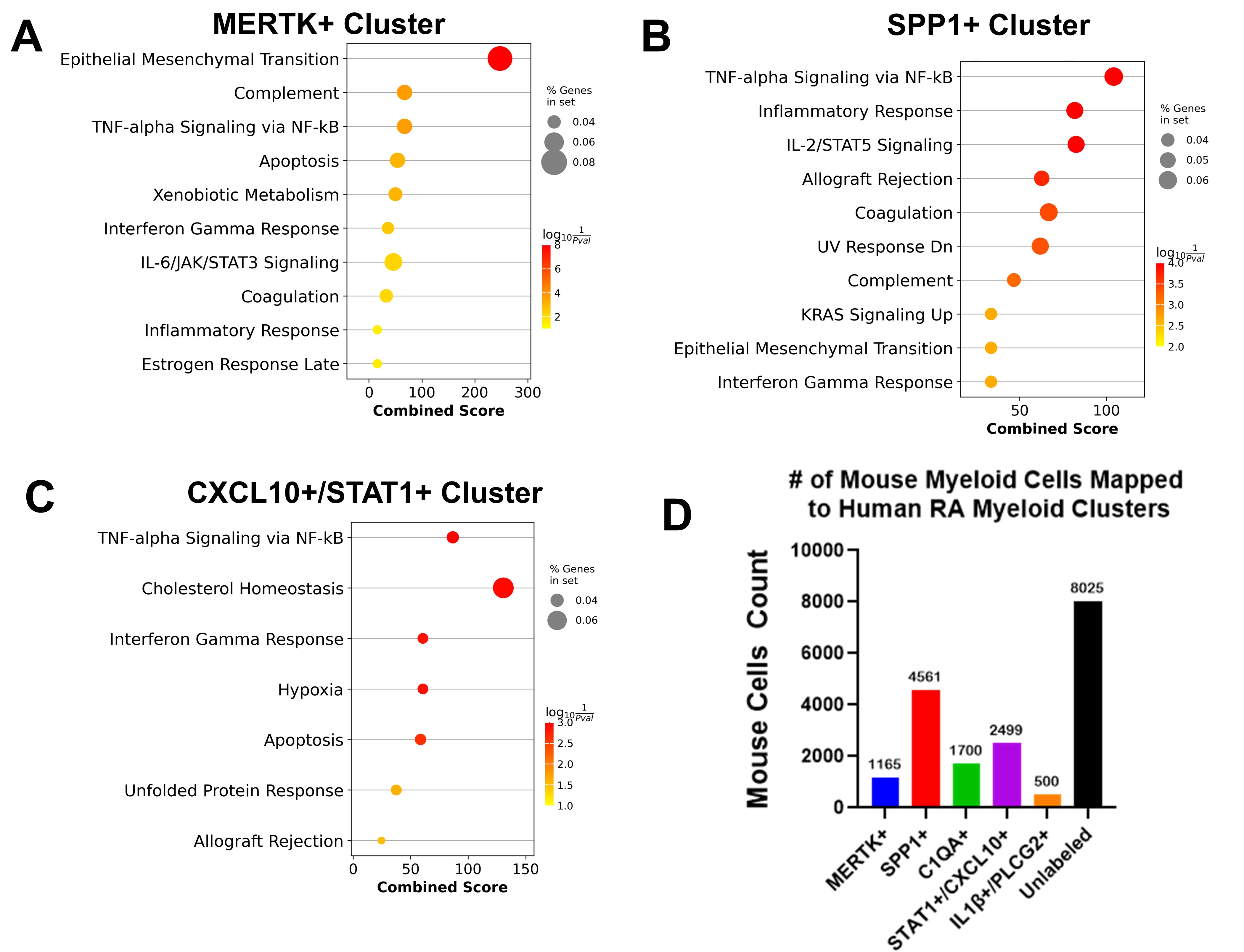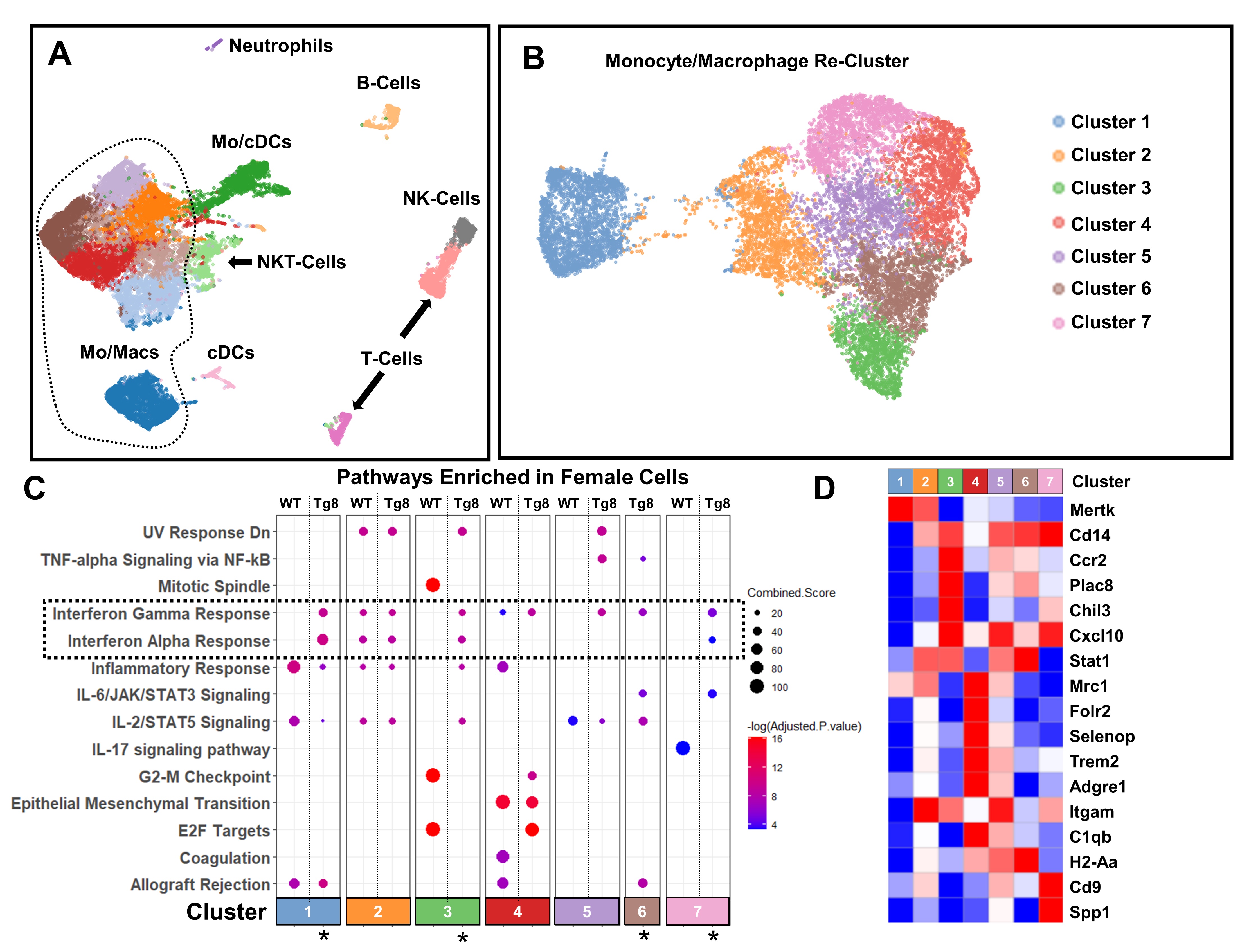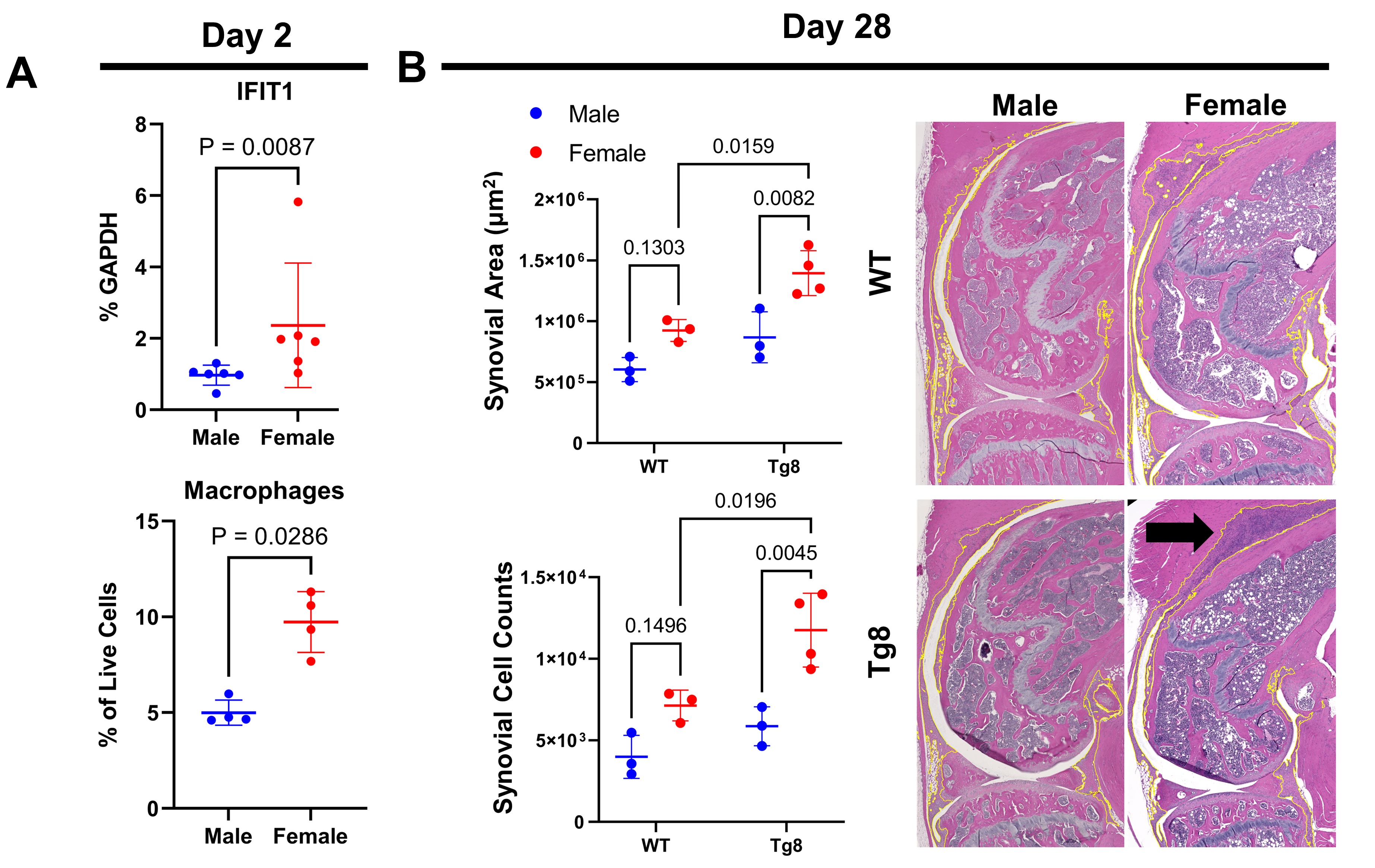Plenary Session
Rheumatoid arthritis (RA)
Session: Plenary I (0722–0726)
0724: Synovial Macrophage Subsets Defined by ScRNAseq Demonstrate Sexually Dimorphic Gene Expression in RA and a Mouse Inflammatory Arthritis Model
Sunday, November 12, 2023
11:45 AM - 11:55 AM PT
Location: Exhibit Hall A-B
- RB
Richard Bell, PhD
Hospital for Special Surgery
New York, NY, United StatesDisclosure(s): No financial relationships with ineligible companies to disclose
Plenary Presenter(s)
Richard Bell, Ewurama Cann, Chao Yang, Accelerating Medicine Partnership Rheumatoid Arthritis, Amit Lakhanpal, Laura Donlin and Lionel Ivashkiv, Hospital for Special Surgery, New York, NY
Background/Purpose: Macrophages (MФ) play a key pathogenic role in Rheumatoid Arthritis (RA), a disease that exhibits female sex bias. Recent work using scRNAseq has defined putative pathogenic synovial MФ subtypes in RA. It is not known whether these MФ subtypes exhibit sexually dimorphic gene expression that can contribute to female sex bias. Additionally, the causal role of RA MФ subsets in inflammatory arthritis is difficult to ascertain in the absence of a disease model that recapitulates these cells' phenotype and gene expression. We tested the hypothesis that pathogenic MФ subsets express higher levels of inflammatory genes in females, and developed a mouse model that recapitulates select RA MФ subsets and the sexually dimorphic gene expression pattern.
Methods: We analyzed the myeloid scRNAseq data from the Accelerating Medicines Partnership-RA (AMP-RA) consortium1 comprised of ~76K cells from human synovial biopsies with RA clustered into 5 MФ subsets (MERTK+, SPP1+, C1QA+, CXCL10+/STAT1+ and IL1β+/PLCG2+). We performed differential gene expression (DEG) and GSEA between female (n=55) and male (n=20) RA subjects. Zymosan induced arthritis (ZIA) was induced via intra-articular injection of 180 ug of zymosan in female and male, WT and Tg8 (transgenic for human TLR8) mice.scRNAseq of synovial tissue CD45+ cells depleted of neutrophils at peak ZIA disease, D7 and DEG with GSEA between female and male mice was performed. We also performed qPCR analysis of FACS-sorted immune cells at D2 of disease and histologic analysis at D28. To assess the similarity between human RA and ZIA, we performed scRNAseq mouse-to-human (M2H) transfer learning to map mouse cells to human defined clusters. Appropriate t-test and two-ANOVA's with Tukey's post-hoc tests were used for all statistical analysis.
Results: GSEA demonstrated that the MERTK+, SPP1+ and CXCL10+/STAT1+ RA myeloid synovial cell clusters showed significant female bias in IFN and other inflammatory pathways (Fig 1A-C, FDR < 0.05, LFC >1). The M2H model produced high quality predictions with an overall F1 score of 0.76 ± 0.1 and revealed that ~60% of cells in the mouse ZIA synovium map to human RA synovial myeloid cell subsets (Fig 1D) validating our approach. After sub-setting the myeloid cells in ZIA synovium (Fig 2A) and re-clustering (Fig 2B), 4 of 7 clusters (C1, C3, C6 and C7) were enriched in IFN pathways in Tg8 female cells (FDR< 0.05, logFC > 1, Fig 2C, marked with *). These cell clusters represent tissue resident MФ (C1: Ccr2-, MerTK+); inflammatory monocytes (C3 & C6: Ccr2+, Chil3+); and inflammatory MФ (C7: Cd14+, Cd9+, Spp1+, Fig 2D). In addition, qPCR confirmed female specific increase of ISGs in MФ with concomitant increase in CD11b+ cell abundance by flow cytometry on D2 (Fig 3A). This Tg8 female specific gene signature translates into histologic differences at D28 (Fig 3B).
Conclusion: This is the first demostration of sexually dimporhic myeloid gene signatures in human RA. We also validate the ZIA mouse model by mapping to human RA and demostrate that it is sexually dimorphic. We are currently exploring mechanistics studies to determine the roles of sex dependent factors, like steroid hormone signaling and X-inactivation, and their specific interactions with the IFN signaling axis.



R. Bell: None; E. Cann: None; C. Yang: None; A. Rheumatoid Arthritis: None; A. Lakhanpal: None; L. Donlin: Bristol-Myers Squibb(BMS), 2, Stryker, 2; L. Ivashkiv: None.
Background/Purpose: Macrophages (MФ) play a key pathogenic role in Rheumatoid Arthritis (RA), a disease that exhibits female sex bias. Recent work using scRNAseq has defined putative pathogenic synovial MФ subtypes in RA. It is not known whether these MФ subtypes exhibit sexually dimorphic gene expression that can contribute to female sex bias. Additionally, the causal role of RA MФ subsets in inflammatory arthritis is difficult to ascertain in the absence of a disease model that recapitulates these cells' phenotype and gene expression. We tested the hypothesis that pathogenic MФ subsets express higher levels of inflammatory genes in females, and developed a mouse model that recapitulates select RA MФ subsets and the sexually dimorphic gene expression pattern.
Methods: We analyzed the myeloid scRNAseq data from the Accelerating Medicines Partnership-RA (AMP-RA) consortium1 comprised of ~76K cells from human synovial biopsies with RA clustered into 5 MФ subsets (MERTK+, SPP1+, C1QA+, CXCL10+/STAT1+ and IL1β+/PLCG2+). We performed differential gene expression (DEG) and GSEA between female (n=55) and male (n=20) RA subjects. Zymosan induced arthritis (ZIA) was induced via intra-articular injection of 180 ug of zymosan in female and male, WT and Tg8 (transgenic for human TLR8) mice.scRNAseq of synovial tissue CD45+ cells depleted of neutrophils at peak ZIA disease, D7 and DEG with GSEA between female and male mice was performed. We also performed qPCR analysis of FACS-sorted immune cells at D2 of disease and histologic analysis at D28. To assess the similarity between human RA and ZIA, we performed scRNAseq mouse-to-human (M2H) transfer learning to map mouse cells to human defined clusters. Appropriate t-test and two-ANOVA's with Tukey's post-hoc tests were used for all statistical analysis.
Results: GSEA demonstrated that the MERTK+, SPP1+ and CXCL10+/STAT1+ RA myeloid synovial cell clusters showed significant female bias in IFN and other inflammatory pathways (Fig 1A-C, FDR < 0.05, LFC >1). The M2H model produced high quality predictions with an overall F1 score of 0.76 ± 0.1 and revealed that ~60% of cells in the mouse ZIA synovium map to human RA synovial myeloid cell subsets (Fig 1D) validating our approach. After sub-setting the myeloid cells in ZIA synovium (Fig 2A) and re-clustering (Fig 2B), 4 of 7 clusters (C1, C3, C6 and C7) were enriched in IFN pathways in Tg8 female cells (FDR< 0.05, logFC > 1, Fig 2C, marked with *). These cell clusters represent tissue resident MФ (C1: Ccr2-, MerTK+); inflammatory monocytes (C3 & C6: Ccr2+, Chil3+); and inflammatory MФ (C7: Cd14+, Cd9+, Spp1+, Fig 2D). In addition, qPCR confirmed female specific increase of ISGs in MФ with concomitant increase in CD11b+ cell abundance by flow cytometry on D2 (Fig 3A). This Tg8 female specific gene signature translates into histologic differences at D28 (Fig 3B).
Conclusion: This is the first demostration of sexually dimporhic myeloid gene signatures in human RA. We also validate the ZIA mouse model by mapping to human RA and demostrate that it is sexually dimorphic. We are currently exploring mechanistics studies to determine the roles of sex dependent factors, like steroid hormone signaling and X-inactivation, and their specific interactions with the IFN signaling axis.

Figure 1. Human RA Female macrophages subsets are enriched with inflammatory and IFN gene signature. We performed DEG and GSEA analysis between male and female subjects within each putative pathogenic MФ cluster. In 3 clusters (SPP1+, CXCL10+/STAT1+, and MERTK+ clusters), female cells were enriched with IFN related pathways (IFN-γ Response, EMT, Allograft Rejection) and other inflammatory pathways (TNF signaling, Inflammatory Response, A-C). To validate our mouse model, we built a mouse-to-human transfer learning model (a five-fold cross validated gradient boosted decision tree) to classify the human cell types (MERTK+; SPP1+, C1QA; STAT1+/CXCL10; IL1β/PLCG2). The model produced high quality predictions with an overall F1 score of 0.76 ± 0.1. This model was then transferred to the mouse dataset via mouse-to-human gene mapping and used to predict which human cluster each mouse cell is in. This analysis reveals that mouse ZIA synovium map to relevant sexually dimorphic human cell clusters (D).

Figure 2. scRNAseq reveals Tg8 Female specific monocyte/macrophage sub-clusters that are enriched with IFN genes. scRNAseq of synovial CD45+ cells depleted of neutrophils on day 7 of ZIA show distinct clusters of immune cells, and sub clusters of monocyte/macrophages in UMAP space (A&B). Differential gene expression comparing male WT to female WT and male Tg8 to female Tg8 with subsequent gene set enrichment shows clusters 1, 3, 6 & 7 (Asterisks) are enriched in IFN related genes (Dotted Box) in female Tg8 cells (D). Mean expression of marker genes per cluster demonstrate that cluster 1 and 2 are proliferating tissue resident macrophages (Ccr2-, Cd14-, Mrc1+, MerTK+), Cluster 3, 5, and 6 are inflammatory monocytes (CD14+, Ccr2+ Chil3+, Plac8+, and Ly6c2+) with cluster 6 being MHCII+, cluster 4 are other tissue resident M2-like macrophages (Mrc+, Trem2+, Adgre1+) and cluster 7 is a monocyte derived inflammatory macrophages (CD14+, CD9+, Spp1+). Analysis: R, Orchestrating Single Cell Experiments, deSeq2, EnrichR, Two-way ANOVA with Tukey’s post-hoc tests. scRNAseq: 4 mice pooled per group; Mo/cDC: Monocyte Derived or Conventional Dendritic Cells; Mo/Macs: Monocyte or Macrophages; NK: Natural Killer.

Figure 3. Early increase in IFIT1 in female macrophages with a concomitant increase macrophage abundance in female synovium that leads to increased synovitis at Day 28. On Day 2 after ZIA, FACS sorted F4-80+, CD11b+ macrophages show an increase of ISG expression, one example shown here IFIT1, in female cells. Macrophage numbers are also increased in female mice (A). Histologic analysis at Day 28 indicates that Female Tg8 mice develop increased synovial area and cell counts (B). H&E representative images are presented in the right panel with the synovium outlined in Yellow, note the large synovial reaction still present in the Tg8 female only (Arrow).
R. Bell: None; E. Cann: None; C. Yang: None; A. Rheumatoid Arthritis: None; A. Lakhanpal: None; L. Donlin: Bristol-Myers Squibb(BMS), 2, Stryker, 2; L. Ivashkiv: None.



